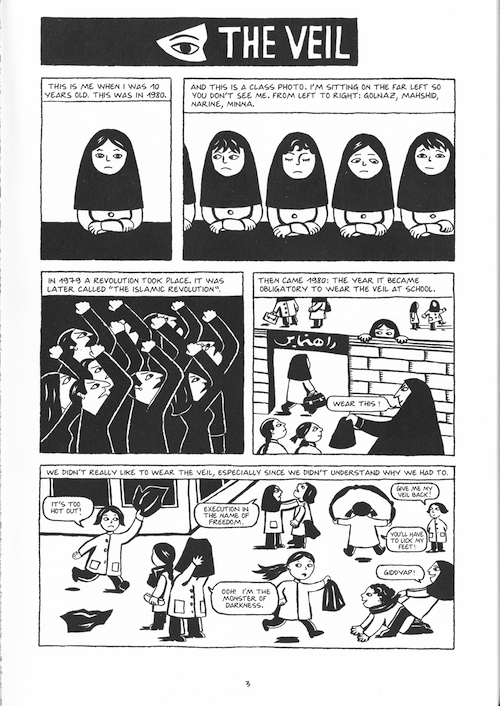
The first page of Persepolis (2000), by Marjane Satrapi. Fair use rationale.
Persepolis is a graphic memoir written and illustrated by Marjane Satrapi. It is the story of Marjane’s coming of age during and after the Iranian Revolution of 1978 and the Iran-Iraq war. The title comes from the name for a historic Iranian city which was once the capital of the Persian Empire. The animated film adaptation of Persepolis received an Academy Award nomination for Best Animated Picture in 2007.
The first volume of the memoir deals with Marjane’s childhood in Tehran, under the Islamic fundamentalism of the Ayatollah Khomeini’s regime. Marjane came from an educated family who taught her to question authority. Even before the revolution, Marjane was born with religion. From the age of six, she wanted to grow up to be a prophet, to be “justice, love and the wrath of God all in one.” She knew that she could right all the injustices she saw, from classism to her grandmother’s aching knees. Marjane lost her religious faith after the regime executed her beloved Uncle Anoosh.
As a young teenager, Marjane experimented with breaking rules at both school and home. Her parents were proud of their daughter’s intellect and spirited nature. They even smuggled posters of Kim Wilde and Iron Maiden for Marjane from outside of the country. One day, Marjane argued with her principal over wearing jewellery to school. She hit the principal, which led to her immediate expulsion from school. At her new school, Marjane contradicted the teachers. Her parents worried that she would become a victim of the regime.
Islamic texts forbade the killing of female virgins, so the regime forced young female prisoners to marry their guards. They were then subjected to rape. After the girl’s execution, the regime would send a dowry to her family. This would be their only acknowledgement of the horrible thing they had done. Marjane’s parents sent her to complete high school in Austria, so that Marjane’s teenage rebellion would not cost their daughter her life.
The second volume of Persepolis details Marjane’s life from age fourteen into her early twenties. It explores Marjane’s feelings of alienation, growing up away from her family and culture. Many Austrians showed prejudice toward refugees, so Marjane sometimes felt the need to hide her heritage. The other high school students often romanticized war and revolution. This enraged Marjane, who had lived through violence and repression. She also found Austria’s social mores much less strict than in Iran. Marjane had to figure out for herself how to navigate life in a place where no-one shared her point of view. Without a community to care for her, Marjane felt adrift and briefly became homeless. She chose to return to Iran to start university.
This page is the first one in Persepolis. It uses a simpler, more childlike art style than the second half of the memoir. This page shows how girls in Tehran reacted to the Islamization of the Iranian elementary school system in 1979. The regime called for all children to attend single-sex Islamic schools. Marjane found this confusing after previously attending a coeducational, secular French-language school. As her school years went on, Marjane felt disillusioned with the pressured for students to support the new regime. This included requiring the girls to take part in ritualized shows of devotion to martyrs for the faith. There were also constant messages that the regime was peaceful and just to its people, even as Marjane and her classmates could see this was untrue.
Even in a single-sex school, students and teachers had to wear Islamic dress. Marjane refers to this as “the veil.” Western popular culture often portrays girls and women in Islamic dress as interchangeable. Whether girls wear the veil from choice or not, this is a stereotype which makes life more difficult for Muslim girls. It ignores girls’ individuality. It also places the blame on them for the Islamophobia they experience by implying that it is their fault for making themselves different. One of the wonderful things about Persepolis is how Marjane avoids this stereotype. Marjane draws her female friends and classmates with deliberate differences in their nose and eye shape, hair and facial expression. Marjane does this even in the first half of Persepolis, where the art style is much simpler and more childlike than the chapters dealing with her adolescence and young adulthood. This artistic choice shows that Iranian girls and women are individuals, whether they wear the veil or not.
